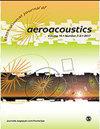Leveraging large eddy simulations to assess noise source imaging of a controlled supersonic jet
IF 1.3
4区 工程技术
Q3 ACOUSTICS
引用次数: 1
Abstract
Noise source imaging based on phased array measurements is an essential tool in the aeroacoustic analysis of new nozzle designs, especially at full-scale. This investigation aims to assess the capability of a deconvolution-based beamforming technique to accurately estimate the changes in noise sources for model-scale heated military jets when fluid inserts are used for noise control. This goal is achieved by performing well-validated Large Eddy Simulations (LES) to complement the experimental measurements. The LES data is segregated into its hydrodynamic, acoustic and thermal components using Doak’s Momentum Potential Theory (MPT). The near-field MPT-derived components are subjected to Spectral Proper Orthogonal Decomposition (SPOD) to compare with the frequency-dependent noise source maps obtained directly from experiments. It is shown that fluid inserts alter the naturally occurring Kelvin-Helmholtz (K-H) instability in the jet shear layer, which leads to a change in the directivity of the noise radiated in the near-field. The upstream shift in the noise source distribution resulting from the modified K-H instability is accurately captured by the deconvolution-based source imaging technique using just the far-field measurements. These changes in source locations as a function of frequency are documented.利用大涡模拟来评估受控超音速喷气机噪声源成像
基于相控阵测量的噪声源成像是新喷嘴设计的气动声学分析的重要工具,尤其是在全尺寸下。本研究旨在评估基于去卷积的波束形成技术在使用流体插入物进行噪声控制时准确估计模型规模加热军用喷气式飞机噪声源变化的能力。这一目标是通过执行验证良好的大涡模拟(LES)来补充实验测量来实现的。使用Doak的动量势理论(MPT)将LES数据分为流体动力学、声学和热分量。对近场MPT导出的分量进行频谱固有正交分解(SPOD),以与直接从实验中获得的频率相关噪声源图进行比较。研究表明,流体插入改变了射流剪切层中自然发生的Kelvin-Helmholtz(K-H)不稳定性,这导致近场辐射噪声的方向性发生变化。通过仅使用远场测量的基于去卷积的源成像技术,精确地捕获了由修改的K-H不稳定性引起的噪声源分布的上游偏移。记录了源位置随频率的变化。
本文章由计算机程序翻译,如有差异,请以英文原文为准。
求助全文
约1分钟内获得全文
求助全文
来源期刊

International Journal of Aeroacoustics
ACOUSTICS-ENGINEERING, AEROSPACE
CiteScore
2.10
自引率
10.00%
发文量
38
审稿时长
>12 weeks
期刊介绍:
International Journal of Aeroacoustics is a peer-reviewed journal publishing developments in all areas of fundamental and applied aeroacoustics. Fundamental topics include advances in understanding aeroacoustics phenomena; applied topics include all aspects of civil and military aircraft, automobile and high speed train aeroacoustics, and the impact of acoustics on structures. As well as original contributions, state of the art reviews and surveys will be published.
Subtopics include, among others, jet mixing noise; screech tones; broadband shock associated noise and methods for suppression; the near-ground acoustic environment of Short Take-Off and Vertical Landing (STOVL) aircraft; weapons bay aeroacoustics, cavity acoustics, closed-loop feedback control of aeroacoustic phenomena; computational aeroacoustics including high fidelity numerical simulations, and analytical acoustics.
 求助内容:
求助内容: 应助结果提醒方式:
应助结果提醒方式:


